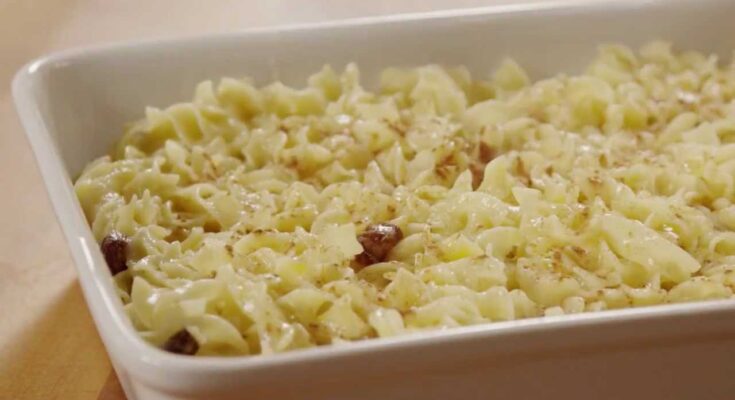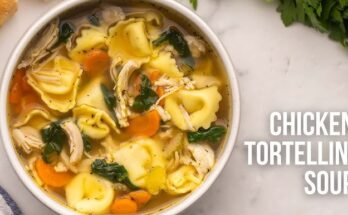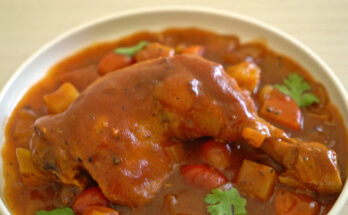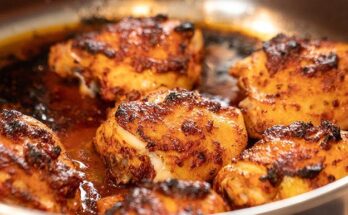Noodle Kugel Recipe: Noodle Kugel is a traditional Jewish casserole dish made primarily with egg noodles, eggs, dairy (like cottage cheese, sour cream, and butter), sugar, and flavorings such as cinnamon or vanilla. Often served during Jewish holidays like Rosh Hashanah or Yom Kippur, it’s a dish that bridges comfort and celebration. The texture is soft yet firm, sweet yet creamy—a perfect harmony that feels like a hug on a plate.
Think of it as a sweet baked pudding with a custard base that holds the noodles together. Depending on regional traditions, it can be made sweet with raisins and sugar or savory with onions and sour cream. Sweet versions are especially beloved in American-Jewish households.
The History and Origin of Noodle Kugel
The origins of kugel trace back over 800 years to Germany, where the word “kugel” means “ball” or “round.” The earliest versions were made with bread and later evolved into using noodles (lokshen), giving birth to the now-famous “Lokshen Kugel.” As Jewish communities migrated to Eastern Europe and later to America, the dish evolved—cream cheese, sour cream, and sugar were added, transforming it into the sweet noodle kugel we know today.
This dish became a staple at Shabbat dinners and festive gatherings, symbolizing comfort and community. Over time, kugel adapted to every region’s pantry, with families passing down their own secret ingredient combinations for generations.
Why You’ll Love This Classic Jewish Dish
Noodle Kugel is more than just food—it’s a tradition served with love. It’s a dish that can be enjoyed warm or cold, making it versatile for any occasion. The combination of creamy custard, tender noodles, and golden-brown crispy edges offers a satisfying contrast of textures and flavors.
Whether you’re cooking for a family holiday or just craving something nostalgic and cozy, noodle kugel is a recipe that warms both heart and home. It’s simple to make, kid-friendly, and perfect for make-ahead meals.
Ingredients You’ll Need for Noodle Kugel
Core Ingredients for a Traditional Sweet Kugel
Here’s a list of the essential ingredients you’ll need to make a classic sweet noodle kugel that serves about 8–10 people:
| Ingredient | Quantity | Notes |
|---|---|---|
| Egg noodles (wide) | 12 oz (340 g) | Cooked until tender |
| Eggs | 5 large | Adds richness and structure |
| Cottage cheese | 2 cups | Creates the creamy texture |
| Sour cream | 1 cup | Adds tanginess and moisture |
| Cream cheese | 4 oz (softened) | Optional for extra creaminess |
| Unsalted butter (melted) | ½ cup | Adds flavor and richness |
| Sugar | ¾ cup | Adjust to taste |
| Milk | ½ cup | Helps blend the custard |
| Vanilla extract | 2 tsp | Enhances sweetness |
| Ground cinnamon | 1 tsp | Adds warmth and aroma |
| Salt | ¼ tsp | Balances the flavors |
| Raisins | ½ cup | Optional but traditional |
| Cornflakes or breadcrumbs | ½ cup | For a crunchy topping |
These ingredients create the sweet, custard-like base with a light, creamy texture that defines a great kugel.
Optional Add-ins and Variations
Want to put your own spin on the traditional kugel? Try these variations:
- Apple Kugel: Add 2 peeled and sliced apples for a fruity, caramelized flavor.
- Pineapple Kugel: Stir in ½ cup of crushed pineapple for a tropical sweetness.
- Savory Kugel: Skip the sugar and vanilla; instead, add sautéed onions, garlic, salt, and pepper.
- Nut Topping: Mix chopped pecans or walnuts with cinnamon and sugar for an irresistible crunchy top.
- Gluten-Free Option: Use gluten-free egg noodles without changing the other ingredients.
These tweaks can personalize your kugel and suit your family’s preferences perfectly.
Ingredient Substitutions for Dietary Preferences
If you’re catering to specific dietary needs, here are easy substitutions that won’t compromise taste:
- Dairy-Free Version: Replace cottage cheese and sour cream with non-dairy alternatives like almond or coconut yogurt. Use vegan butter instead of dairy butter.
- Low-Sugar Version: Swap sugar for natural sweeteners like honey, maple syrup, or monk fruit.
- Low-Fat Version: Use low-fat cottage cheese and sour cream for a lighter version.
- Egg Substitute: For an egg-free version, use a flaxseed or chia egg replacement (1 tbsp ground flaxseed + 3 tbsp water per egg).
With these options, everyone can enjoy this beloved dish—no matter their dietary preferences.
Step-by-Step Guide to Making Noodle Kugel
Step 1: Gather and Prepare Your Ingredients
Start by preheating your oven to 350°F (175°C). Grease a 9×13-inch baking dish with butter or cooking spray. Gather all ingredients and set them on your counter—it makes the process smooth and efficient.
Measure everything before you start cooking. This simple prep step saves time and helps avoid mistakes. Make sure your cream cheese and butter are softened at room temperature so they blend easily with the other ingredients.
Step 2: Cook the Egg Noodles Perfectly
Bring a large pot of salted water to a boil. Add your egg noodles and cook them until just tender (about 6–7 minutes). Avoid overcooking—they’ll continue to cook while baking. Drain and set aside to cool slightly.
Toss the noodles with a small knob of butter to prevent sticking. This small trick ensures the noodles stay separate and silky when mixed with the creamy custard later.
Step 3: Mix the Sweet Creamy Base
In a large mixing bowl, combine the cottage cheese, sour cream, cream cheese, sugar, milk, melted butter, eggs, vanilla extract, cinnamon, and salt. Use a whisk or hand mixer to blend everything together until smooth and creamy. The consistency should be similar to a custard base—rich, thick, and slightly sweet.
This creamy mixture is what gives the kugel its signature flavor. If you prefer a lighter texture, blend the cottage cheese in a food processor before mixing it in. This step helps eliminate lumps and makes the custard silky smooth.
Once your base is ready, gently fold in the cooked noodles and raisins (if using). Stir carefully to ensure every noodle is coated evenly in the creamy mixture. Be gentle—overmixing can break the noodles and affect the final texture.
If you’d like to experiment, now’s the perfect time to add extras like grated apples, pineapple chunks, or a handful of crushed cornflakes for added crunch. The beauty of kugel is how easily it adapts to your taste.
Step 4: Combine and Layer the Kugel
Pour the noodle mixture into your prepared baking dish. Spread it evenly using a spatula to ensure the custard settles between all the noodles. A smooth, even layer helps it bake uniformly.
For an irresistible finishing touch, prepare a topping mixture of crushed cornflakes, cinnamon, and a tablespoon of sugar. Sprinkle this evenly over the top. It creates a delicious golden crust that adds both flavor and texture.
Some families like to drizzle a little melted butter over the topping before baking—it enhances the color and crispness. If you want to make it extra special, sprinkle chopped nuts or a few more raisins on top.
Your kugel is now ready for the oven! Place it on the center rack to ensure even baking.
Step 5: Bake to Golden Perfection
Bake your noodle kugel at 350°F (175°C) for 50–60 minutes, or until the top is golden brown and the custard is set. You’ll know it’s ready when the center doesn’t jiggle and the edges turn a beautiful golden hue.
As it bakes, your kitchen will fill with the warm aroma of vanilla, cinnamon, and butter—pure comfort! Once done, remove it from the oven and let it cool for at least 15–20 minutes before slicing. This resting time helps the custard firm up, making it easier to cut clean slices.
You can serve kugel warm for a soft, creamy texture or chilled for a firmer, dessert-like consistency. Both ways are equally delicious—it’s really up to your preference.
Tips for the Best Noodle Kugel
Achieving the Perfect Texture
The texture of a perfect noodle kugel is what makes it memorable. You’re aiming for a tender inside with a slightly crisp, caramelized top. Here’s how to get it right:
- Don’t overcook the noodles. Slightly underdone noodles will absorb the custard perfectly during baking.
- Balance moisture. Too much milk or sour cream can make the kugel soggy; too little can dry it out.
- Let it rest. Allowing the kugel to sit before serving helps it firm up and enhances the flavors.
- Use full-fat ingredients. This gives the richest, creamiest result—worth every bite!
If you notice your kugel browning too quickly on top, loosely cover it with foil halfway through baking. This trick ensures the inside cooks evenly while keeping the top golden, not burnt.
Sweet vs. Savory Kugel Differences
While this guide focuses on the sweet version, it’s worth exploring the savory kugel, which is equally popular in Jewish cuisine.
- Sweet Kugel: Includes sugar, raisins, cinnamon, vanilla, and sometimes fruit like apples or pineapple. It’s often served as a dessert or side dish during holidays.
- Savory Kugel: Made with onions, garlic, salt, and pepper—sometimes even cheese. It’s ideal for lunch or dinner, pairing perfectly with roasted meats or vegetables.
If you’ve never tried both, make one of each and discover which your family prefers—it’s a delicious experiment!
How to Prevent Overbaking or Dryness
Nothing’s worse than a dry kugel, but it’s an easy mistake to avoid:
- Don’t overbake. Once the center is firm and lightly golden, it’s done. Overbaking will cause it to lose moisture.
- Keep the oven temperature consistent. Avoid opening the door too often, as this causes heat loss and uneven baking.
- Add a bit of extra milk if the mixture looks too thick before baking. It helps keep the noodles moist.
- Cover with foil for the first 30 minutes if you’re using a convection oven—this prevents the top from drying out too fast.
Follow these steps, and you’ll get that perfect creamy yet firm texture every time.
Serving Suggestions and Pairings
When and How to Serve Noodle Kugel
Noodle Kugel is incredibly versatile—it can be served as a side dish, brunch casserole, or dessert. Traditionally, it’s part of Jewish holiday meals, especially during Rosh Hashanah, Yom Kippur, or Shabbat dinners.
Here are a few serving ideas:
- Serve it warm alongside roasted chicken or brisket for a comforting dinner.
- Pair it with fresh fruit salad or yogurt for a sweet brunch.
- Enjoy it chilled with a drizzle of honey or a sprinkle of powdered sugar as dessert.
Some families even serve kugel during breakfast—it’s that flexible! Its slightly sweet, custardy flavor pairs beautifully with coffee or tea, making it a treat any time of day.
Delicious Side Dishes and Drinks to Pair With
Pair your kugel with dishes that balance its richness:
- Main Courses: Roasted chicken, brisket, or baked salmon.
- Sides: Green beans almondine, roasted carrots, or apple compote.
- Drinks: A light white wine like Riesling complements sweet kugel, while black coffee enhances the dessert experience.
For festive occasions, serve kugel with a dollop of whipped cream or a side of fresh berries—it looks beautiful and adds a burst of freshness.
Storing and Reheating Instructions
How to Store Leftovers Properly
One of the best things about noodle kugel is how well it keeps! You can easily make it ahead and store leftovers for later without losing that creamy texture or comforting flavor.
Once your kugel has cooled completely, cover the baking dish tightly with plastic wrap or aluminum foil. You can also transfer individual portions into airtight containers. Stored properly in the refrigerator, it will stay fresh for up to 4–5 days.
If you plan to keep it longer, freezing is an excellent option. Slice the kugel into portions and wrap each piece tightly in plastic wrap, then place them in a freezer-safe ziplock bag or airtight container. When stored correctly, frozen kugel will last for up to 3 months without losing much quality.
Pro tip: Always label your container with the date before freezing. It helps you track freshness and prevents freezer burn.
When you’re ready to enjoy it again, just thaw it overnight in the refrigerator. This gradual thawing process helps preserve the texture and flavor better than defrosting it quickly.
The Best Ways to Reheat Kugel Without Losing Flavor
Reheating kugel can be tricky—if done wrong, it can dry out or turn rubbery. But with a few simple tips, you can bring it back to its freshly baked glory.
Here’s how:
- Oven Method (Best Option): Preheat your oven to 325°F (160°C). Place the kugel in an oven-safe dish and cover it with foil to prevent it from drying out. Heat for 15–20 minutes, or until it’s warmed through. If you want to restore some crispness to the top, remove the foil during the last 5 minutes of reheating.
- Microwave Method (Quick Option): Place a single serving on a microwave-safe plate, cover with a damp paper towel, and heat in 30-second intervals until warm. Be careful not to overheat—it can make the noodles rubbery.
- From Frozen: For frozen kugel, allow it to thaw in the refrigerator first, then follow one of the reheating methods above. You can also reheat directly from frozen at 325°F for about 40–45 minutes if you’re short on time.
A great tip: sprinkle a teaspoon of milk or cream over the top before reheating—it helps rehydrate the noodles and keeps the kugel moist and creamy.
Common Mistakes to Avoid When Making Noodle Kugel
Even though noodle kugel is a relatively simple dish, there are a few common pitfalls that can affect the taste or texture. Here’s what to watch out for:
- Overcooking the Noodles: Remember, the noodles will continue cooking in the oven. If they’re too soft before baking, they’ll turn mushy afterward. Always boil them until just tender (al dente).
- Skipping the Cooling Step: After boiling, let the noodles cool slightly before mixing them into the custard base. Adding hot noodles can scramble the eggs in your mixture—resulting in a curdled texture.
- Using Too Much Liquid: Too much milk or sour cream can make the kugel soggy. Stick to the recommended measurements unless you’re adjusting for more noodles.
- Neglecting to Butter the Dish: Greasing your baking dish ensures the kugel doesn’t stick and gives the edges a nice golden crisp.
- Overbaking: Once the top is golden and the center is firm, remove it from the oven. Overbaking dries out the custard, making the kugel tough.
- Not Letting It Rest Before Serving: Patience pays off! Allow your kugel to rest for 15–20 minutes before slicing. It firms up beautifully and slices cleanly without falling apart.
Avoid these mistakes, and your noodle kugel will come out picture-perfect every single time.
FAQs about Noodle Kugel Recipe
1. Can I make noodle kugel ahead of time?
Yes! Noodle kugel is perfect for preparing ahead. You can assemble it a day before baking and store it covered in the refrigerator. When ready, bake it straight from the fridge, adding about 10 minutes to the baking time.
2. How do I make noodle kugel less sweet?
If you prefer a less sweet version, reduce the sugar to ½ cup and skip the raisins. You can also add a pinch more salt or a splash of lemon juice to balance the flavors.
3. What’s the difference between lokshen kugel and noodle kugel?
“Lokshen” simply means “noodle” in Yiddish. Lokshen kugel refers to the same dish—though some families use the term to distinguish traditional Eastern European recipes from Americanized versions with cream cheese or fruit.
4. Can I freeze baked noodle kugel?
Absolutely! Let it cool completely, then wrap tightly in plastic wrap and foil. It will keep well in the freezer for up to 3 months. Thaw overnight in the fridge before reheating.
5. Is noodle kugel served hot or cold?
Both ways are delicious! Serve it warm for a soft, custardy texture, or chilled for a firmer, dessert-like feel. Many people enjoy it cold the next day—it’s just as tasty.
Conclusion
From its creamy custard base to the tender egg noodles and that irresistible golden crust, every bite is filled with warmth and sweetness. The beauty of kugel lies in its versatility—you can make it sweet or savory, add fruits or nuts, and even adjust it to fit different dietary needs.
So, the next time you’re craving something hearty yet homey, whip up a batch of homemade noodle kugel. With this step-by-step guide, you’ll master the art of making it perfectly every time—crispy on the outside, creamy on the inside, and bursting with flavor.
Whether you enjoy it hot or cold, for breakfast or dessert, noodle kugel is one of those dishes that never fails to make you feel right at home.



